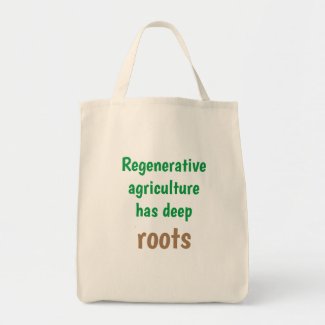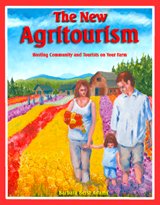The "Fill Your Pantry" marketing complement to farmers' markets
Copyright National Lilac Publishing, LLC -- A version of this article by Barbara Berst Adams was first published in AcresUSA
Lonesome Whistle Farm is one of many regenerative and sustainable farms that have taken part in an Oregon autumn event called Fill Your Pantry (FYP). Though the owners utilize a variety of market outlets including traditional farmers' markets, FYPs are popular for customers who want to stock up on much larger quantities of staples at a single event. Eco-producers of various storage crops or preserved foods use these events to move large quantities -- sometimes very large quantities -- of crops before winter.
Erinn Criswell is the organizer of an FYP in the state’s largest city of Portland through her involvement with Friends of Family Farmers (FoFF), a grassroots group supporting socially and environmentally responsible family-scale agriculture. She’s noticed the value of FYPs for the farmers’ bottom line. “FYP encourages consumers to stock their pantries for the winter months which in turn relieves the farmers of products they would otherwise need to sell or store during the winter,” Criswell said. “Farmers who participate in FYP type events off-load hundreds of pounds of storage crops in one day. Their sales from one FYP event rivals their sales from several winter farmers markets.”
The FoFF Fill Your Pantry event in Portland is relatively new. Various other organizations within Oregon’s rich eco-farming arena have sponsored or co-sponsored FYPs in other locations since several years back. The volunteer Ten Rivers Food non-profit began hosting FYPs beginning in 2009 and have continued ever since. Oregon’s Willamette Farm and Food Coalition describes the FYP programs they’ve helped sponsor as a “farm direct community bulk buying event.” These FYPs may offer dry beans, grains, nuts, honey, root veggies, garlic, onions, winter squash, and pasture raised meats. Each FYPs offerings are different, depending on which producers participate. Storable fruits and cured or preserved products may also be offered as long as they are provided in high enough quantities. Even dairies have participated, offering longer term storable cheese.
Locations for these events have included elementary schools, county fairgrounds, and former church buildings.They are often held on Sundays in late October or early November, although Criswell said an FYP is planned for an upcoming early January.
Each FYP is usually held as a one-day event even though there are multiple independent FYPs held on various dates. Sometimes customers can come by and “shop,” but often, customers are encouraged or even required to order a minimum amount ahead of the actual event (for example, a minimum of 100 pounds). This structure appears beneficial to the events’ success. “There are definitely advantages of selling product online in advance of the event both for the farmers’ bottom line and popularity with customers,” Criswell said. “For the farmers, during the pre-order, their products sell with very little time investment required; they arrive the day of the event already knowing how much money they are taking home with them; and they can arrange their orders at home on their own time. For the customers, they have the advantage of taking time with their orders. They can aggregate orders with friends and family before making the purchase, and browse the producers’ growing practices, pricing options, and variety for up to two weeks before investing in their winter food needs.”
To start an FYP, obviously a group needs to determine if enough nearby producers can supply storables in high enough quantity at a one time event. With a solid core group, date and reserved location, plus an FYP organizer with the ability to process online sales, it can be helpful to start early to generate customers. “I would reach out to farmers markets whose doors close for the winter and ask them to promote the stock-up event to their customers,” Criswell said. “Additionally, I would reach out to any food/farm organizations in the area: PTAs, community organizations, buyers clubs, etc.” Criswell also sent out press releases. She said although none of theirs were picked up by the press, she still recommends them because each location’s media is different. In addition to what Criswell said, local and regional media are dynamic, changing from year to year. If there was no room or interest for FYP coverage in a certain year, there might well be room or interest for it the following year. Other possible customer sources could be local churches which may have interested members or even private retirement communities which are showing signs of embracing local food sources.
The need for attractive product presentation can be different for FYPs than for regular farmers markets, and depends on the farmers’ goals. “Since the vast majority of products are sold during pre-order,” Criswell said, “some farmers come to the FYP market with orders already assembled in totes or boxes.” She said that other vendors just assembled the orders as the customers came with their order slip. She noticed the latter mostly with the grain vendors. If their market booth was organized by their different products (such as oats, red fife wheat, corn, etc), they would just grab the items as the customer came to them. But she said most vendors still brought a market set-up intending to sell more beyond the pre-orders the day of, and they did augment their sales that way, while just some vendors strictly came only to the event with what they had pre-sold. “If the intention is to sell more product the day of the event, then a keen market display is certainly a benefit,” she said, even though some vendors weren’t too interested in that aspect because of the short window to both sell new product and hand out pre-orders simultaneously.
As more staple and storage crop farmers enter the regenerative ranching and farming arena, this platform for distribution can be of great value to their success, as well as a helpful option for their customers. They can go hand in hand with traditional farmers' markets, or create an outlet for growers whose products or farming schedules don't fit into farmers' market rules. The more successful direct distribution programs we have, the better for all.





